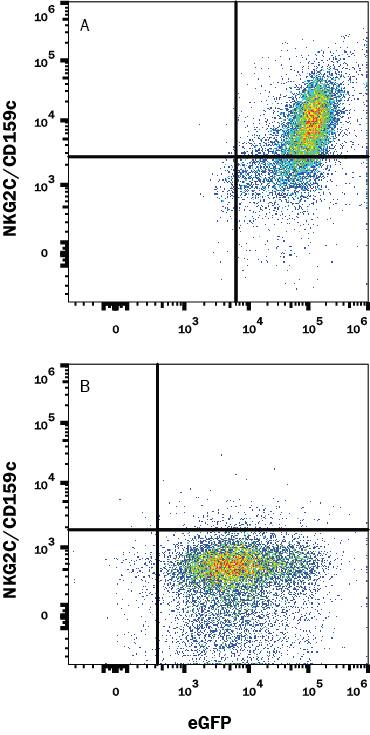Mouse NKG2C/CD159c Antibody
R&D Systems, part of Bio-Techne | Catalog # MAB1382
Recombinant Monoclonal Antibody.


Conjugate
Catalog #
Key Product Details
Species Reactivity
Mouse
Applications
CyTOF-ready, Flow Cytometry
Label
Unconjugated
Antibody Source
Recombinant Monoclonal Rabbit IgG Clone # 2098A
Product Specifications
Immunogen
Mouse NKG2C/CD159c synthetic peptide
Accession # NP_034783
Accession # NP_034783
Specificity
Detects mouse NKG2C/CD159c in direct ELISAs. In Flow Cytometry, no cross-reactivity with mouse NKG2A/CD159a is observed.
Clonality
Monoclonal
Host
Rabbit
Isotype
IgG
Scientific Data Images for Mouse NKG2C/CD159c Antibody
Detection of NKG2C/CD159c in HEK293 Human Cell Line Transfected with Mouse NKG2C/CD159c and eGFP by Flow Cytometry.
HEK293 human embryonic kidney cell line transfected with either (A) mouse NKG2C/CD159c or (B) mouse NKG2A/CD159a and eGFP was stained with Rabbit Anti-Mouse NKG2c/CD159c Monoclonal Antibody (Catalog # MAB1382) followed by APC-conjugated Anti-Rabbit IgG Secondary Antibody (Catalog # F0111). Quadrant markers were set based on control antibody staining (Catalog # MAB1050). View our protocol for Staining Membrane-associated Proteins.Applications for Mouse NKG2C/CD159c Antibody
Application
Recommended Usage
CyTOF-ready
Ready to be labeled using established conjugation methods. No BSA or other carrier proteins that could interfere with conjugation.
Flow Cytometry
0.25 µg/106 cells
Sample: HEK293 Human Cell Line Transfected with Mouse NKG2C/CD159c and eGFP
Sample: HEK293 Human Cell Line Transfected with Mouse NKG2C/CD159c and eGFP
Formulation, Preparation, and Storage
Purification
Protein A or G purified from cell culture supernatant
Reconstitution
Reconstitute at 0.5 mg/mL in sterile PBS. For liquid material, refer to CoA for concentration.
Formulation
Lyophilized from a 0.2 μm filtered solution in PBS with Trehalose. *Small pack size (SP) is supplied either lyophilized or as a 0.2 µm filtered solution in PBS.
Shipping
Lyophilized product is shipped at ambient temperature. Liquid small pack size (-SP) is shipped with polar packs. Upon receipt, store immediately at the temperature recommended below.
Stability & Storage
Use a manual defrost freezer and avoid repeated freeze-thaw cycles.
- 12 months from date of receipt, -20 to -70 °C as supplied.
- 1 month, 2 to 8 °C under sterile conditions after reconstitution.
- 6 months, -20 to -70 °C under sterile conditions after reconstitution.
Background: NKG2C/CD159c
References
- Orbelyan, G.A. et al. (2014) J. Immunol. 193:610.
- Tassi I. et al. (2006) Immnunol Rev. 214:92.
- Lanier, L.L. (2008) Nat. Immunol. 9:495.
- Schleinitz, N. et al. (2010) Immunology. 174:2878.
- Lopez-Botet, M. et al. (2000) Hum. Immunol. 61:7.
- Braud, V.M. et al. (1998) Nature. 391:795.
- Lanier, L.L. (1998) Immunity 8:693.
- Vance, R.E. et al. (1999) J Exp Med 190:1801.
- Kaiser B.K. et al. (2005) J Immunol 174:2878.
- Bellón T. et al. (1999) J Immunol 162:3996.
- Pupuleku A. et al. (2017) Front Immunol. 8:1317.
- Hammer Q. et al. (2018) Nat Immunol. 19:453.
Long Name
Natural Killer G2C
Alternate Names
CD159c, KLRC2, NKG2-C
Gene Symbol
KLRC2
UniProt
Additional NKG2C/CD159c Products
Product Documents for Mouse NKG2C/CD159c Antibody
Product Specific Notices for Mouse NKG2C/CD159c Antibody
For research use only
